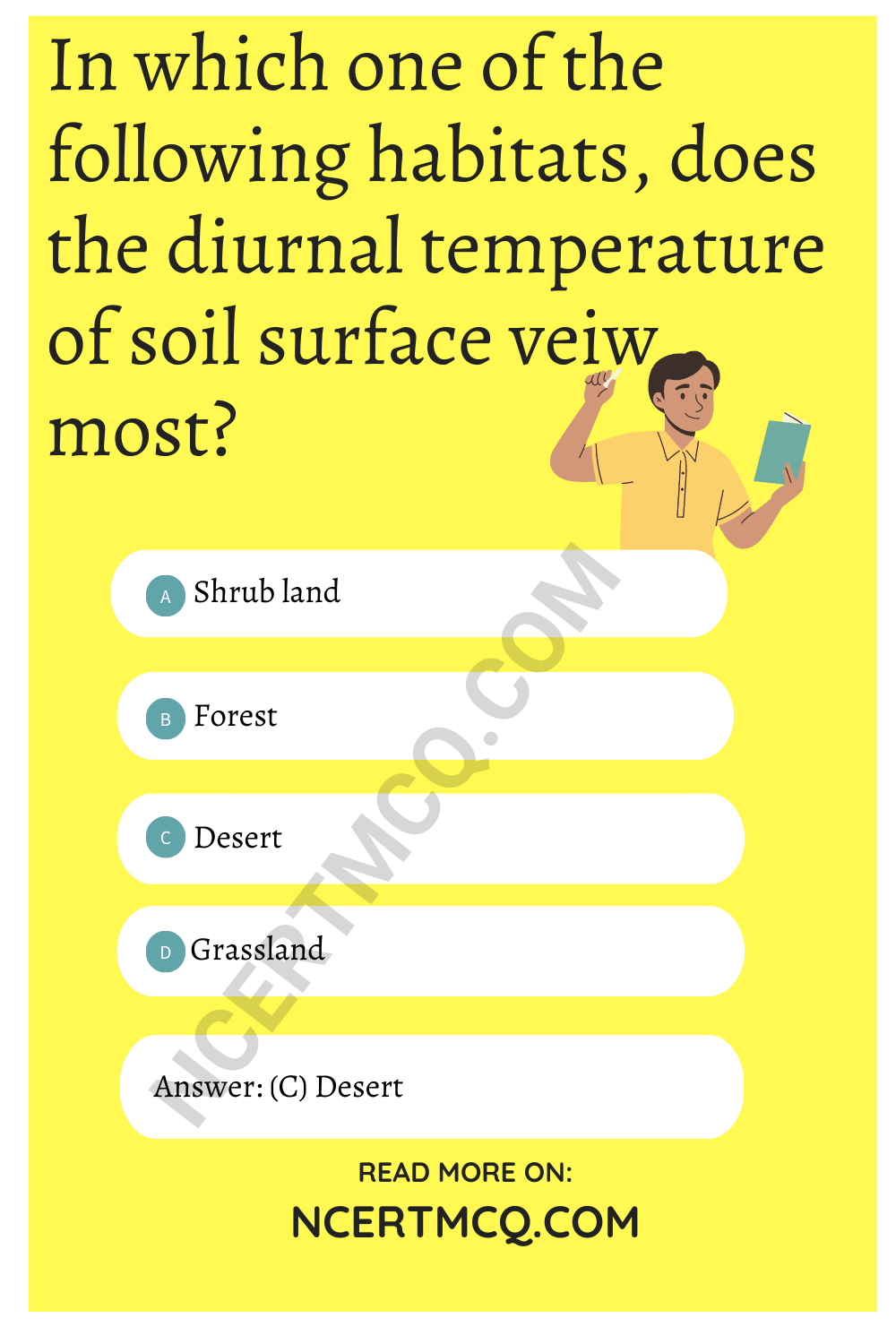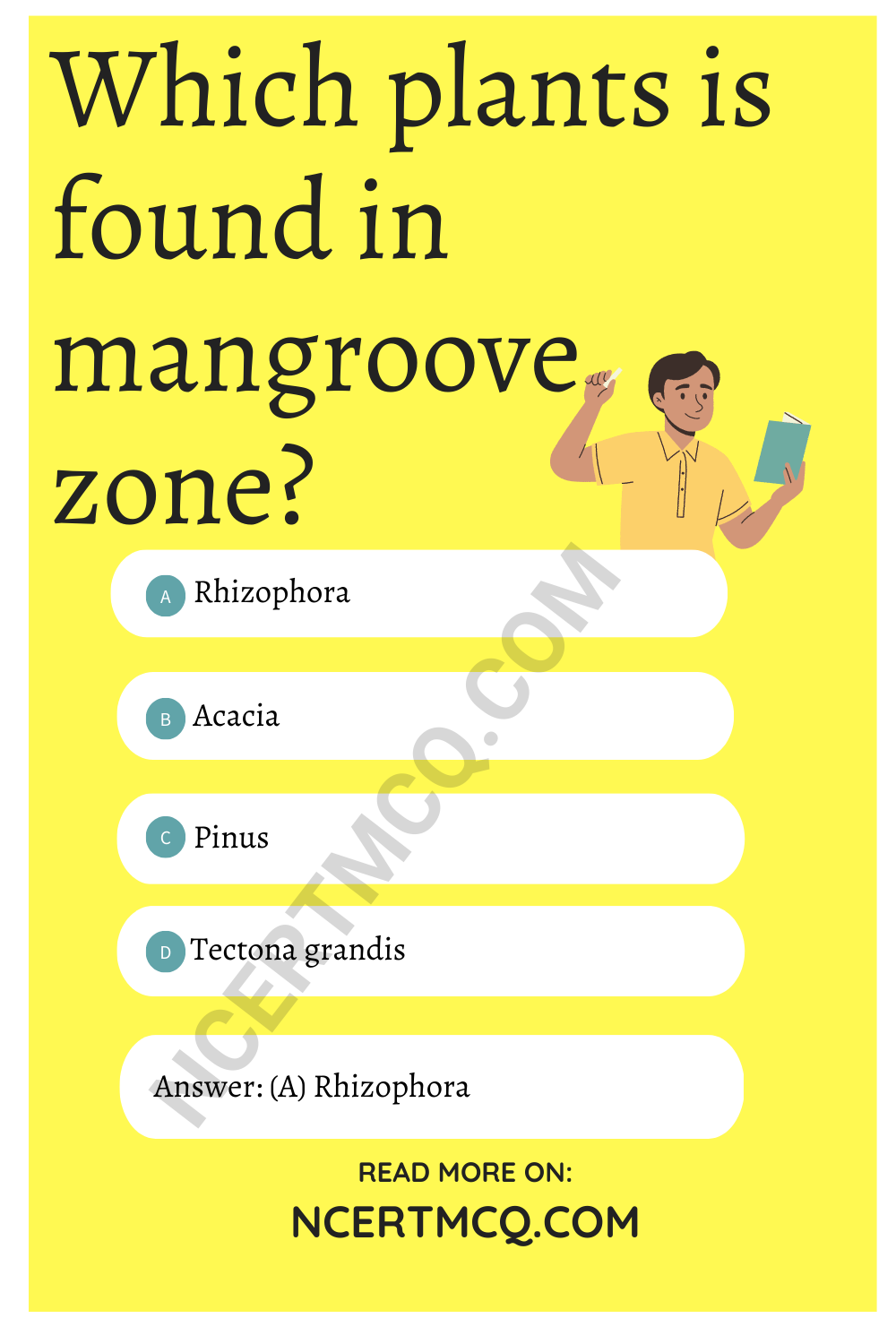Check the below NCERT MCQ Questions for Class 12 Biology Chapter 13 Organisms and Populations with Answers Pdf free download. MCQ Questions for Class 12 Biology with Answers were prepared based on the latest exam pattern. We have provided Organisms and Populations Class 12 Biology MCQs Questions with Answers to help students understand the concept very well.
Class 12 Biology Chapter 13 MCQ With Answers
Biology Class 12 Chapter 13 MCQs On Organisms and Populations
MCQ On Organism And Population Class 12 Chapter 13 Question 1.
Habitat together with functions of a species constitute its:
(a) Topography
(b) Trophic level
(c) Boundary
(d) Ecological niche
Answer
Answer: (d) Ecological niche
Class 12 Biology Chapter 13 MCQ Questions Question 2.
The maximum growth rate occurs in :
(a) Lag phase
(b) Exponential, phase
(c) Stationary phase
(d) Senescent phase
Answer
Answer: (b) Exponential, phase
Organism And Population Class 12 MCQ Chapter 13 Question 3.
In which one of the following habitats, does the diurnal temperature of soil surface veiw most?
(a) Shrub land
(b) Forest
(c) Desert
(d) Grassland
Answer
Answer: (c) Desert

Organisms And Population Class 12 MCQ Chapter 13 Question 4.
Science linking heredity with environment is:
(a) Ecology
(b) Ecophysiology
(c) Genecology
(d) Genetics
Answer
Answer: (c) Genecology
Organisms And Population MCQ With Answers Chapter 13 Question 5.
Submerged hydrophytes havedisseced leaves for:
(a) Decreasing surface area
(b) Increasing surface area
(c) Reducing effect pf water currents
(d) Increasing number of stomata
Answer
Answer: (c) Reducing effect pf water currents
Organism And Population MCQ Chapter 13 Class 12 Question 6.
Water holding capacity is maximum in:
(a) Clay
(b) Sand
(c) Silt
(d) Gravel
Answer
Answer: (a) Clay
MCQ On Organism And Population Chapter 13 Class 12 Question 7.
Animals undergo inactive stage during winters. It is called :
(a) Acclimatisation
(b) Hibernation
(c) Aestivation
(d) Adapatation
Answer
Answer: (b) Hibernation
Organisms And Populations MCQ Chapter 13 Class 12 Question 8.
Praying mantis is a good example of:
(a) Camouflage
(b) Mullarian mimicry
(c) Warning colouration
(d) Social insect
Answer
Answer: (a) Camouflage
MCQ On Organisms And Population Chapter 13 Class 12 Question 9.
Niche overlap is:
(a) Mutualism between two species
(b) Active cooperation between two species
(c) Tjvo different parasites on same food
(d) Sharing resources between two species
Answer
Answer: (d) Sharing resources between two species
Organisms And Population MCQ Chapter 13 Class 12 Question 10.
Animals have innate ability to escape from predation. Select the incorrect example:
(a) Colour change in Chameleon
(b) Enlargement of body by swallowing air in puffer fish
(c) Poison fangas of snakes
(d) Melaninin in moths
Answer
Answer: (c) Poison fangas of snakes
MCQ Organism And Population Chapter 13 Class 12 Question 11.
Ozone protects biosphere from high energetic:
(a) Infra-red rays
(b) Ultraviolet rays
(c) X-rays
(d) gamma rays
Answer
Answer: (b) Ultraviolet rays
MCQ Of Organism And Population Chapter 13 Class 12 Question 12.
Avicennia, Rhizophora andAtriplex are:
(a) Xerophytes
(b) Halophytes
(c) Hydrophytes
(d) Mesophytes
Answer
Answer: (b) Halophytes
MCQs On Organism And Population Chapter 13 Class 12 Question 13.
Maximum amounts of humus occurs on:
(a) In lower most layer
(b) In upper layer
(c) In Middle layer
(d) Same everywhere
Answer
Answer: (b) In upper layer
MCQs On Organisms And Population Chapter 13 Class 12 Question 14.
Mycorrhiza is an example to:
(a) Decomposers
(b) Endoparasitism
(c) Symbiotic relationship
(d) Ectoparasitism
Answer
Answer: (c) Symbiotic relationship
Organism And Population Class 12 MCQ Pdf Chapter 13 Question 15.
Plants growing in saline soil with high salt concentration are:
(a) Xerophytes
(b) Halophytes
(c) Heliophytes
(d) Hydrophytes
Answer
Answer: (b) Halophytes
Question 16.
When births are equal to deaths, it is:
(a) Plateau stage
(b) Exponential stage
(c) Early growth stage
(d) Acceleration stage
Answer
Answer: (a) Plateau stage
Question 17.
Which plants is found in mangroove zone?
(a) Rhizophora
(b) Acacia
(c) Pinus
(d) Tectona grandis
Answer
Answer: (a) Rhizophora

Question 18.
Soil transported by air is:
(a) Alluvial
(b) Glacial
(c) Colluvial
(d) Eolian
Answer
Answer: (d) Eolian
We hope the given NCERT MCQ Questions for Class 12 Biology Chapter 13 Organisms and Populations with Answers Pdf free download will help you. If you have any queries regarding Organisms and Populations CBSE Class 12 Biology MCQs Multiple Choice Questions with Answers, drop a comment below and we will get back to you soon.
Class 12 Biology MCQ:
- Reproduction in Organisms Class 12 MCQ
- Sexual Reproduction in Flowering Plants Class 12 MCQ
- Human Reproduction Class 12 MCQ
- Reproductive Health Class 12 MCQ
- Principles of Inheritance and Variation Class 12 MCQ
- Molecular Basis of Inheritance Class 12 MCQ
- Evolution Class 12 MCQ
- Human Health and Disease Class 12 MCQ
- Strategies for Enhancement in Food Production Class 12 MCQ
- Microbes in Human Welfare Class 12 MCQ
- Biotechnology: Principles and Processes Class 12 MCQ
- Biotechnology and its Applications Class 12 MCQ
- Organisms and Populations Class 12 MCQ
- Ecosystem Class 12 MCQ
- Environmental Issues Class 12 MCQ
